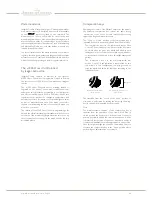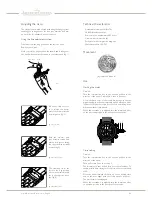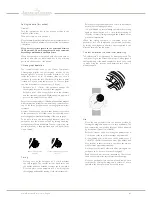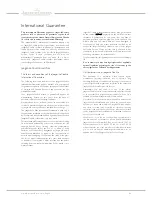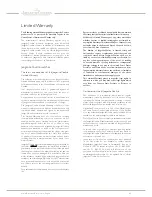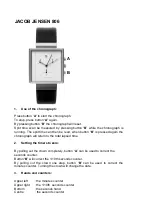
Water resistance
Jaeger-LeCoultre Master Compressor Chronograph watches
are water-resistant to 10 bar/atm. This property is identifiable
by the
symbol engraved on the case-back. This
means that you can use your watch for short swims, and
when diving from the poolside, but not from a diving board. It
must not be used either for scuba diving or for sports where
there are significant risks of hard knocks, such as windsurfing
and waterskiing. Please also note that leather straps are not
suitable for aquatic activities.
It is also essential to have the water resistance of your watch
regularly checked by an authorised Jaeger-LeCoultre retailer
at least once every 2 years, and definitely before any period in
which it will undergo prolonged and / or regular immersion.
The «1000 Hours Control» test
by Jaeger-LeCoultre
Jaeger-LeCoultre subjects its watches to the rigorous
«1000 Hours Control» test programme. Unique in its kind,
this test consists of 1000 hours of comprehensive, stringent
checks.
The «1000 Hours Control» seal or marking, affixed or
engraved on the back of your watch, certifies that it has
undergone this observation programme in our laboratories
and has successfully passed all tests. The latter include rate
regularity checks, reactions to changes in temperature and
barometric pressure, resistance to shocks and magnetic fields,
as well as water-resistance tests. Your watch is therefore
capable of withstanding the trials of everyday life when you
wear it on your wrist.
The criteria of the «1000 Hours Control» programme go far
beyond the official timekeeping test standards, which concern
only part of the movement. Jaeger-Lecoultre tests not only
the movement before casing it in the watch, but also the fully
assembled watch.
Compression keys
Equipping the crowns of the Master Compressor line models,
the patented compression key system can apply strong
compression to one of the 4 crown seals, thereby ensuring
impeccable long-term water resistance.
The “open” or “closed” position of the compression key is
indicated by the arrow symbols (viewed from the dial side) :
- The compression key is in the compressed seal position
(“closed”) if the indication is a white arrow; the keys must
be closed when you wear your watch and when you are
taking part in sports. You must not make any adjustments
or set the time in this position, since this might damage the
gaskets.
- The compression key is in the non-compressed seal
position (“open”) if the indication is represented by two
red arrows; in this configuration, you may proceed to
start the watch and adjust the functions according to the
indications below.
The transition from the “closed” to the “open” position, or
vice-versa, is performed by turning the key using the wing-
nuts in the direction indicated by the arrow(s).
Note
The water-resistance function of the compression key is
separate from the operation of the crown itself. Even in
closed position, the key does not lock the crown. It is thus in
practice possible to handle the crown when the key is in the
compressed seal position. However, as mentioned earlier, it
is extremely inadvisable to make adjustments in this position,
since this might damage the seals. We recommend that you
first turn the compression key to the “open” position before
performing any adjustments on your watch.
Wing-nuts
Compressed seal position or
"closed" position
Non-compressed seal position or
"open" position
M
aster
C
oMpressor
C
hronograph
- English
2/6


